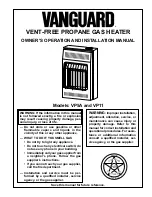
22
100271597
HOT-WATER
OUTLET
COLD-
WATER
INLET
UNION
TEMPERATURE-
PRESSURE
RELIEF VALVE
DISCHARGE PIPE
(DO NOT CAP OR
PLUG)
300mm (12 in.) MAX.
AIR GAP BELOW
DISCHARGE PIPE
METAL
DRAIN
PAN
FLOOR
DRAIN
DRAIN
VALVE
SHUT-OFF VALVE
SOME
COMPONENTS
NOT SHOWN
FOR CLARITY.
SIDE TAP
(OUTLET)
SIDE TAP
(INLET)
Figure 22
FILLING THE WATER HEATER
•
Avoid water heater damage.
•
Fill tank with water before operating.
Property Damage Hazard
CAUTION
•
Do not insert the power cord into the electrical
receptacle until the heater has been fully installed.
•
Never use this water heater unless it is completely full
of water. To prevent damage to the tank, the tank must
be filled with water. Water must flow from the hot-water
faucet before turning “ON” gas to the water heater.
To fill the water heater with water:
1. Close the water heater drain valve by turning handle
to the right (clockwise). The drain valve is on the lower
front of water heater (see Figure 22).
2. If the heater is equipped with plumbing side taps and
they are not connected to piping, ensure that the side
taps have been closed with pipe plugs.
3. Open all hot-water faucets served by the water heater
to allow air to escape from the tank and the water
piping. Ensure any shut-off valves between the heater
and the faucets are the open position.
4. Open the cold-water supply valve to the water heater.
Notes:
•
The cold-water supply valve must be left open when
the water heater is in use.
•
Avoid water leakage when filling the tank. Do not
allow the insulation of the water heater to get wet as
water can reduce the effectiveness of the insulation.
5. To ensure complete filling of the tank, allow air to exit.
Check that the nearest hot-water faucet is still open.
Allow water to run until a constant flow is obtained.
This will let air out of the water heater and the piping.
6. Check all water piping and connections for leaks.
Repair as needed.
VENTING
All venting must comply with the current edition of the
“Natural Gas and Propane Installation Code” B149.1
.
This heater is certified to be installed using Schedule 40
PVC or CPVC or polypropylene plastic vent material. All
jurisdictions require that this material is approved to ULC
S636. Only use approved material. All venting material
and components must be joined with the approved primer/
cleaner and solvent cement or mechanical seals (see
“Polypropylene Vent Systems”).
Note:
Use of cellular core PVC (ASTM F891), cellular
core CPVC, or Radel
®
(polyphenylsulfone) in non-metallic
venting systems is prohibited.
For models using the 181° control, use only Schedule 40
CPVC piping and fittings for the first linear 1.5m (5 ft.) of
the outlet vent system. A 1.5m (5 ft.) section of 3” Schedule
40 CPVC vent pipe is supplied with the water heater for
this purpose. If 4” venting is to be used it must be field
supplied. For the rest of the outlet vent system use piping
and fittings as defined above.
Breathing carbon monoxide can cause brain damage or death.
Always read and understand instruction manual.
•
Install vent system In accordance with codes.
•
Do not operate water heater if flood damaged.
•
Install water heater in accordance with the
instruction manual.
•
Do not operate if soot buildup is present.
•
Do not obstruct water heater air intake(s).
•
Do not place chemical vapour emitting products near
water heater.
•
Gas and carbon monoxide detectors are available.
•
Never operate the heater unless it is vented to the
outdoors and has adequate air supply to avoid risks
of improper operation, fire, explosion or asphyxia-
tion.
•
Analyze the entire vent system to make sure that
condensate will not become trapped in a section of
vent pipe and therefore reduce the open cross
sectional area of the vent.
Breathing Hazard - Carbon Monoxide Gas
WARNING
Important:
DO NOT common vent this water heater with
any power vented appliance. DO NOT vent into a common
chimney.
















































